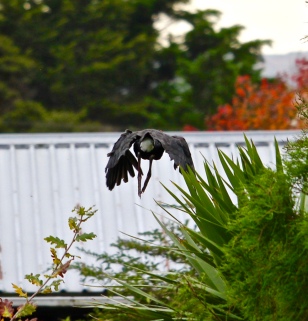The Twelve days of Christmas (Verse 1 New Zealand Version)
On the first day of Christmas
My true love gave to me
A pukeko in a ponga tree.
Pūkeko belong to the rail family and arrived from Australia about the same time as the Maori explorers landed in Aotearoa. They are often seen in open paddocks, cleared land or at the edges of swamps. You can see pūkeko around the wildlife santuary of Western Springs Park in Auckland and in many other city parks with the right habitat. Because people scatter bread for these birds, they have developed different behaviours from pukeko in their natural environment. This is not always for their own better health and welfare as the food has less nutrients and may contain toxic bacteria. They can mistake bits of plastic, paper scraps and other discarded rubbish for food.
They are easily recognized. An attractive, large, ink-blue and black bird almost the size of a chicken with long orange legs and big feet specially designed for walking in wet areas. Above their sturdy orange bill is a bright red face patch or shield covering the forehead and they have red eyes. When they move they flick their tails showing white feathers.
They make shrill, raucous calls to each other. They can be noisy and aggressive, particularly when nesting and will defend their territory from other birds. They can fly. I have seen pūkeko perched awkwardly in a cabbage tree eating fruit with a mate on lookout below but they prefer to run when chased and like other members of the rail family are good swimmers.
They can form groups and share a territory. A group of pūkeko will lay their eggs in the same nest – talk about putting all your eggs in one basket! Every bird in the group helps take care of the young. Their eggs are brown with darker spots or splotches and each female can lay up to 6 eggs, which hatch into cute, black chicks. Because they are smart they can be trained and have starred in TV advertising clips.
They mostly eat plant food including those in our veggie gardens but also eat insects, grubs and small fish. They have adapted well to changing habitat because of their wide diets. Maori and early settlers learnt to build a barrier fence around their precious plants.
Pūkeko are related to the endangered, endemic Takahē.
Pūkeko websites
- Radio NZ Bird Watching – Pūkeko
- What is a pūkeko?
- Birding West Coast pūkeko page
- DOC pūkeko page
- Guardians of Pauatahanui Inlet pūkeko page.





